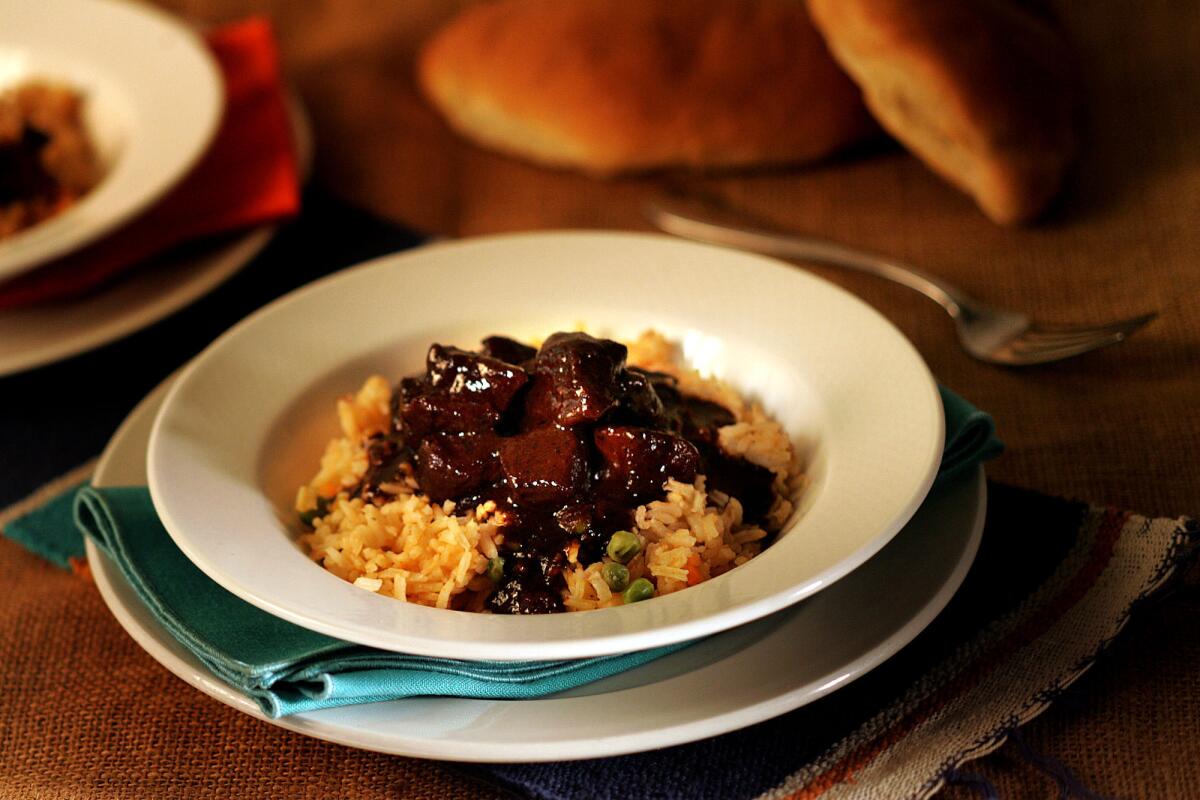Recipe: Jerez-style wedding <i>asado</i> (<i>Asado de boda Jerezano</i>)

Though Southern California is full of people from the Zacatecas state of Mexico, there are hardly any real Zacatecan restaurants in the area, complained Gustavo Arellano, noted OC Weekly columnist and author of the book “Ask a Mexican!” And they certainly don’t serve anything like the food made by his mom, Maria de la Luz Arellano, and his aunt Maria Fernandez. Especially their wedding asado, a long-simmered stew of pork shoulder and chiles. After reading his brief description of the dish, we had to get the recipe. Well, being great home cooks, they didn’t really have one. But we begged and pleaded and they eventually came through. It’s not fast food, not by any means, but this dish has the deep, profound flavors that can come only with long cooking and mother love.
Jerez-style wedding asado (Asado de boda Jerezano)
Total time: About 3 hours
Servings: 32
Note: Serve the dish over Mexican rice, with extra bolillos (Mexican rolls) for sopping up the sauce. Dried chiles can be found at Mexican and well-stocked markets. Bolillos and piloncillo (unrefined sugar, commonly shaped as a cone) can be found at Mexican markets. This makes much more purée than is needed for the final asado, which is good because it is fairly labor-intensive to make. The remaining purée can be frozen, then thawed and used as desired.
8 dried Pasilla chiles
11/2 pounds dried chile chilacate, or red chiles (you can substitute dried New Mexico chiles)
9 pounds boneless pork shoulder
5 tablespoons salt, divided
7 cups lard, divided
7 bolillos, each cut into 4 pieces
3 (6-inch) Mexican cinnamon sticks (canela)
18 ounces Mexican chocolate, preferably in bar form, broken up with a hammer
Peel of 1/2 orange
3 (8-ounce) cones piloncillo, or 3 cups plus 2 tablespoons brown sugar, broken up with a hammer
4 bay leaves
1. Cut the Pasilla and red chiles in half lengthwise, and remove the seeds and stems. Set aside.
2. Cut the pork shoulder into small, thumb-sized pieces (including the skin and fat). Place the pork in a large bowl and toss with 4 tablespoons (one-fourth cup) of the salt.
3. In a large, heavy-bottom skillet or frying pan, heat 3 cups of lard over high heat. When the lard is melted and hot (test the heat with a piece of pork — it should sizzle and crackle when it hits the pan), pan-fry the pork. Fry the pork in a single layer until crisp and golden-brown (this will probably need to be done in batches), 15 to 20 minutes per batch, stirring the pork occasionally so it cooks evenly.
4. Use a slotted spoon to transfer the fried pork from the fat into a large, 8-quart pot and repeat until all of the pork is fried. Once all of the pork is fried, add the fat to the pork in the large pot. Heat the large pot over low heat to keep the pork warm while the rest of the dish is prepared.
5. Clean the skillet, then add 2 cups of lard and heat over high heat. When the lard is hot, pan-fry the bolillo pieces in a single layer until golden brown on all sides, about 2 minutes per batch. Watch that the bolillos do not burn. Place the fried pieces in a very large bowl or container (strain the lard and use it to fry the chiles, or for future frying). Fill the bowl with 1 gallon water to submerge the pieces, and set aside to soak thoroughly.
6. Add the 2 remaining cups lard (start with any leftover lard from frying the bolillos, if kept and strained) to the skillet and heat again over high heat. Flash-fry the chiles (no more than 5 seconds a batch) in the oil, making sure to turn them so both sides are fried. Watch that the chiles do not burn; the burnt flavor will ruin the asado. Strain each batch into a large bowl, continuing until all of the chiles are fried. Remove from heat and strain the lard; cool and store for future use.
7. In a blender, combine the cinnamon sticks with 1 cup water. Purée the cinnamon, then strain the liquid into a separate large pot. Place the strained cinnamon solids into a small bowl.
8. Purée the chiles in batches: Lightly pack one-sixth of the chiles in the blender (most blenders have a 6-cup capacity) with 2 cups water and purée. Strain the chile purée into the large pot with the cinnamon water and place the strained solids into the small bowl with the cinnamon solids. Repeat with the remaining chiles, using a total of 12 cups (3 quarts) water.
9. Place the bolillos in the blender with their remaining soaking water — most should have been absorbed — and add water as needed to fill the blender. Blend to purée, and transfer the purée to the large pot with the puréed chiles and cinnamon.
10. Place the strained solids back into the blender with 1 cup water. Purée once more, then strain into the large pot with the puréed chiles and bolillos. Discard any remaining solids.
11. Stir the pot with the puréed chiles and bolillos to thoroughly combine. This makes about 2 gallons purée.
12. Add the purée, ladle by ladle, to the large pot filled with the pork to desired consistency. It should be somewhere between a stew and a soup. Increase the heat to high. You will probably not use all the purée (we used 3 quarts); the rest of the purée will keep, frozen, for months.
13. Add the chopped chocolate and orange peel to the pot, stirring until the chocolate melts and is incorporated into the sauce.
14. Stir in the chopped piloncillo and bay leaves and continue to heat until the mixture comes to a boil, stirring frequently (be sure to stir the bottom of the pot to prevent the mixture from burning). Taste and adjust the seasoning and flavoring as desired. This makes about 11/2 gallons asado.
Each of 32 servings: 628 calories; 28 grams protein; 43 grams carbohydrates; 3 grams fiber; 39 grams fat; 13 grams saturated fat; 110 mg. cholesterol; 32 grams sugar; 1,123 mg. sodium.
More to Read
Eat your way across L.A.
Get our weekly Tasting Notes newsletter for reviews, news and more.
You may occasionally receive promotional content from the Los Angeles Times.






